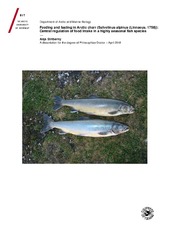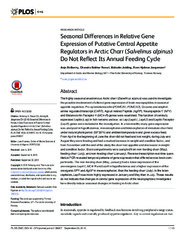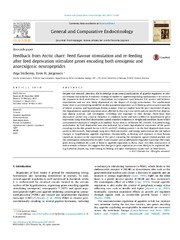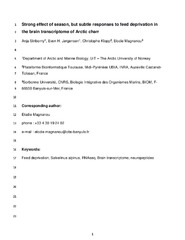| dc.contributor.advisor | Jørgensen, Even H. | |
| dc.contributor.author | Striberny, Anja | |
| dc.date.accessioned | 2018-06-26T12:06:58Z | |
| dc.date.available | 2018-06-26T12:06:58Z | |
| dc.date.issued | 2018-05-22 | |
| dc.description.abstract | Central control mechanisms of food intake vary between different fish species. Few studies
have investigated the role of central appetite regulators in fish species that show natural
seasonal variations in food intake. Yet, seasonal fishes are particularly interesting because
their potential seasonally sliding set-points in appetite and energy homeostasis may reveal
new information about the long-term control of food intake in fish. Arctic charr inhabit the
oligotrophic freshwater systems of the North. The anadromous (sea-migrating) charr cope with
the poor nutritional conditions found in fresh water by performing short feeding migrations to
the nutrient-rich sea for a few weeks in summer. These charr obtain their nutrients almost
entirely from marine food resources and feed little or nothing while residing in fresh water
during the rest of the year. The seasonal feeding rhythm is considered to be under tight
endogenous control because it is sustained in captive offspring of anadromous charr despite
year-round feed access. The mechanisms underlying the seasonal feeding behaviour of the
charr are not understood.<br>
In this work we aimed at shedding light on the role of central appetite regulators in the
control of appetite in Arctic charr. We measured the gene expression of putative appetite
regulators in captive immature offspring of anadromous Arctic charr held at a simulated natural
conditions, as well as in Arctic charr that were subjected to a short and a long period of feed
deprivation. In addition we tested the effects of re-feeding and fish feed flavour on the
expression of hypothalamic appetite regulators in previously long-term feed deprived charr.
Lastly, we compared the brain transcriptome between fed and feed deprived charr over a four
weeks period during summer in order to assess effects of feed deprivation on a larger scale.<br>
Our data indicate that the reduction and increase in appetite during winter and summer,
respectively, are not regulated by changes in central satiety and hunger signalling in the charr.
Furthermore, we could not find differences in central appetite signalling between long-term
energy perturbed and fed charr during summer. We conclude from these findings, that the
charr may enter a steady-state like regulation of appetite when feed is present or absent for a
longer period of time. However, the re-feeding or feed flavour presentation evoked responses
in some appetite regulating genes. Consequently, we suggest that changes in the expression
of central appetite regulators may only be seen during transition phases, from fasting to
feeding, and vice versa, in the Arctic charr. The transcriptomic approach revealed two new
interesting candidate genes, nerve growth-factor inducible (VGF) and deiodinase 2 (Dio2),
which are previously described to participate in the regulation of energy homeostasis in
seasonal mammals. As such this work expands current knowledge about the role of known
appetite regulators and depicts new aspects that may be linked to the food intake control of
seasonal fishes. | en_US |
| dc.description.doctoraltype | ph.d. | en_US |
| dc.description.popularabstract | The anadromous (sea-migrating) Arctic charr (Salvelinus alpinus) feed a lot during their short feeding-migration to the sea during summer and little or nothing during their stay in fresh water during the rest of the year. The seasonal feeding cycle is maintained in captive charr that have year-round feed access. In mammals, appetite and energy homeostasis are regulated by a network of hormones, neuronal signals, and neuroendocrine signals. Many of these appetite regulating mechanisms are also found in fish. However, their function in fish is far from understood. In this work we aimed at revealing the involvement of neuroendocrine signals produced by the brain in the control of food intake in the seasonal Arctic charr. We asked the question, how the charr can stop feeding for months without getting hungry. Our data indicate that changes in central appetite signalling occur only during transition phases from fasting-mode to feeding-mode and vice versa. | en_US |
| dc.description.sponsorship | Research Council of Norway (Aurora Programme): 255581/O30 | en_US |
| dc.identifier.isbn | 978-82-8266-152-2 | |
| dc.identifier.uri | https://hdl.handle.net/10037/13005 | |
| dc.language.iso | eng | en_US |
| dc.publisher | UiT The Arctic University of Norway | en_US |
| dc.publisher | UiT Norges arktiske universitet | en_US |
| dc.rights.accessRights | openAccess | en_US |
| dc.rights.holder | Copyright 2018 The Author(s) | |
| dc.rights.uri | https://creativecommons.org/licenses/by-nc-sa/3.0 | en_US |
| dc.rights | Attribution-NonCommercial-ShareAlike 3.0 Unported (CC BY-NC-SA 3.0) | en_US |
| dc.subject | VDP::Mathematics and natural science: 400::Zoology and botany: 480::Zoophysiology and comparative physiology: 483 | en_US |
| dc.subject | VDP::Matematikk og Naturvitenskap: 400::Zoologiske og botaniske fag: 480::Zoofysiologi og komparativ fysiologi: 483 | en_US |
| dc.title | Feeding and fasting in Arctic charr (Salvelinus alpinus (Linnaeus, 1758)): Central regulation of food intake in a highly seasonal fish species | en_US |
| dc.type | Doctoral thesis | en_US |
| dc.type | Doktorgradsavhandling | en_US |


 English
English norsk
norsk



